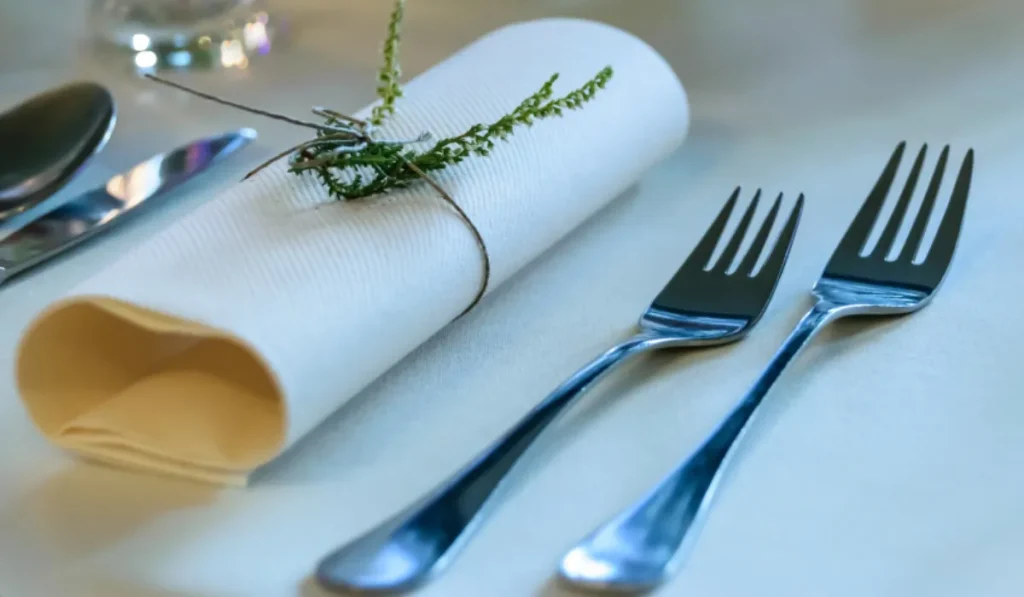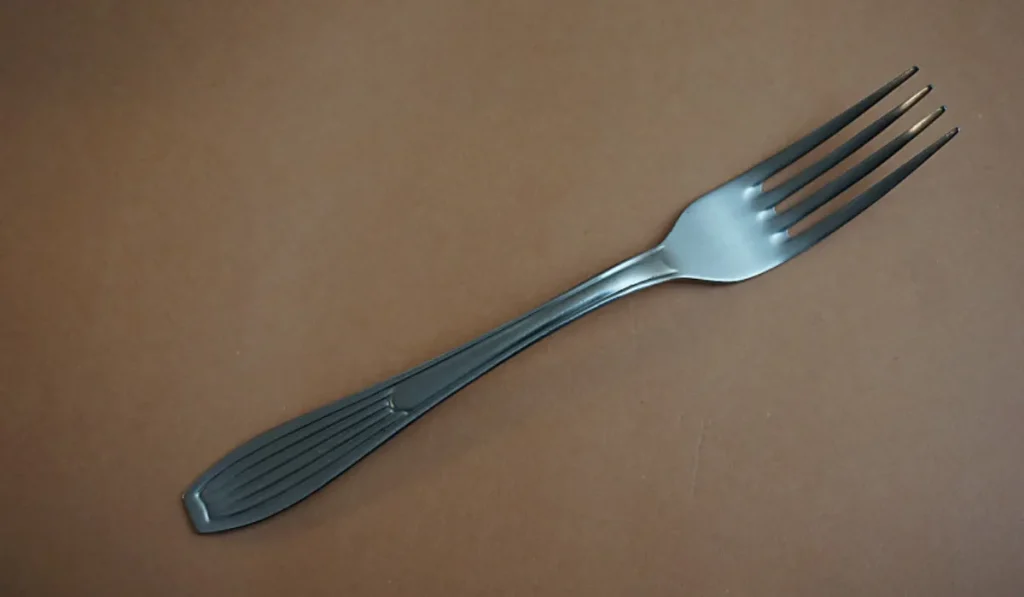On average, a standard dinner fork weighs about 1 ounce (28 grams). The weight of a fork can vary based on design and material.
A simple kitchen utensil, the fork’s history and role in dining are as significant as its function.
Typically made of stainless steel or silver, forks come in various sizes and styles, which can affect their measurements. Heavy-duty or decorative forks, such as those used for serving, may be substantially heavier.
Their design evolution tracks with human culture, transforming from flatware for the elite to an everyday staple.
Fork weights are important for both balance in the hand during meals and durability for long-term use. The exact weight of a fork is essential knowledge when considering shipping for large quantities or assessing the quality of a flatware set.
Average Weight Of A Dinner Fork
Imagine sitting down to a beautiful dinner setting. The centerpiece is the dinner fork, an essential tool for most meals.
But have you ever wondered how much a dinner fork weighs? This utensil’s weight varies based on several factors, but typically, a dinner fork weighs between 20 to 30 grams. That’s about as light as a few sheets of paper!
Material Matters: Stainless Steel Vs. Silver
The material of a fork greatly influences its weight. Stainless steel and silver are the most common materials used. Here’s a quick comparison:
- Stainless Steel Forks: Durable, lightweight, and often used daily. They generally weigh around 20 to 30 grams.
- Silver Forks: Heavier and more traditional. Silver forks can weigh upwards of 40 grams.
Stainless steel forks are the go-to for most homes. Silver forks shine in formal settings. Remember, the weight can add a touch of class to your dining experience.
Dimension And Design: Key Factors In Weight
Not all dinner forks are created equal. The dimensions and design play a vital role in determining the weight of a fork.
A fork with a longer handle or decorative elements may be heavier. The following aspects affect a fork’s weight:
| Feature | Weight Influence |
|---|---|
| Length | A longer fork typically weighs more. |
| Width | A wider fork has more material, hence more weight. |
| Design | Ornate designs can add extra weight. |
| Thickness | A thicker fork feels heavier and sturdier. |
Understand these variations when selecting the perfect fork, as the weight impacts the dining experience. The choice often reflects personal preference and the desired table aesthetic.
Comparative Weights Of Different Types Of Forks

Ever wonder why forks come in different sizes and weights? Each fork type serves a unique purpose.
Understanding fork weights helps in selecting the right one for your meal. This section explores the interesting world of fork weights. We’ll compare common types of forks and their weight differences.
Salad Vs. Dinner Fork
When setting a table, the choice between salad and dinner forks is crucial. Salad forks are smaller and lighter, designed for appetizer courses.
Dinner forks are heftier, intended for the main course. The weight difference also signifies their use. Here’s a look at their comparative weights:
- Salad Fork: Approximately 20 – 30 grams
- Dinner Fork: Approximately 40 – 60 grams
Typically, a dinner fork weighs about twice as much as a salad fork. This weight ensures it can handle a variety of foods.
Specialty Forks: From Cocktail To Carving
Apart from the typical table forks, specialty forks vary widely in weight. From delicate cocktail picks to sturdy carving forks, each serves a specific function. Let’s compare some popular specialty forks:
| Fork Type | Approximate Weight |
|---|---|
| Cocktail Fork | 15 – 20 grams |
| Fish Fork | 30 – 40 grams |
| Carving Fork | 50 – 70 grams |
| Pasta Fork | 30 – 50 grams |
Cocktail forks are light, perfect for small appetizers. Fish forks feature a slightly heavier design for seafood. In contrast, carving forks need to be heavy to hold meat firmly. Similarly, pasta forks balance between lightness for twirling and heaviness for serving.
Understanding the weight of forks enhances dining etiquette and table setting. The right fork choice adds comfort and class to any meal experience.
Manufacturing Processes That Affect Fork Weight

Have you ever wondered why all forks are not the same weight? It’s not just about design or material. The secret lies in how they are made. Different manufacturing methods play a huge role in the final weight of a fork. Let’s dive into the processes that craft the utensils we use every day.
Forging Techniques: Handcrafted Vs. Machine-made
The way a fork is forged can have a significant impact on its weight. Handcrafted forks are often heavier. Craftsmen shape them one at a time, making each unique. Machine-made forks use precise equipment.
This method often results in lighter and more uniform products. Both techniques have their own appeal and contribute to the weight variations we find in the market.
The Impact Of Quality And Brand On Weight
Not all fork brands weigh the same. High-quality brands may use heavier, sturdier materials. Others might opt for lighter weight to reduce costs. The quality of metal, such as stainless steel or silver, affects the fork’s weight.
Prestigious brands often have weightier utensils, as a sign of quality and durability. The brand and quality you choose can influence not only the feel but also the balance of the fork in your hand.
The Role Of Fork Weight In Dining Etiquette
Dining etiquette influences the dining experience in subtle, yet profound ways. The weight of the fork, a seemingly minor detail, plays a crucial role in dining comfort and etiquette.
A well-weighted fork feels balanced and comfortable during a meal, enhancing the overall dining experience.
Balanced Cutlery: Comfort In Hand
Comfort is key during a meal. A fork that is too heavy or too light can disrupt the dining experience. A balanced cutlery piece ensures that guests can enjoy their meal without any potential discomfort or awkwardness caused by improper utensil weight.
- Avoiding hand fatigue with proper weight distribution
- Ensuring ease of use for all courses during a meal
- Providing a sense of quality and luxury through heft
Harmonizing Weight And Style
A well-set table must combine both weight and style in its place setting. The fork weight should match the visual appeal and thematic setting of an event or dinner setting. It directly impacts the diner’s interaction with the meal and the table aesthetics.
| Event Type | Preferred Fork Weight | Cutlery Style |
|---|---|---|
| Casual Breakfast | Lighter | Simplistic Design |
| Formal Dinner | Heavier | Elegant and Detailed |
The right fork weight complements the chosen style and ensures a seamless dining experience. Thus, the fork becomes an integral part of the elegant tableau set for guests.
Surprising Uses For Forks Beyond Dining
Think forks are just for eating? Think again! These everyday utensils hide a world of creativity and practicality.
From the lightest plastic to the heaviest silver, forks weigh in differently. But no matter their weight, their potential extends way beyond your dinner plate. Let’s dive into the unexpected ways forks can be a part of daily life – outside the kitchen!
Creative Arts And Crafts With Forks
Forks transform into tool of imagination in arts and crafts. Check these out:
- Painting tool: Dip fork tines in paint for unique textures.
- Clay sculpting: Create patterns on clay projects.
- Flower making: Forks twist paper into delicate floral shapes.
Kids love making art with unusual items, and forks bring a fun twist to any project.
Practical Life Hacks Using An Ordinary Fork
Ever thought a fork could solve daily annoyances? These life hacks show you how:
| Problem | Fork Hack Solution |
|---|---|
| Stubborn nail polish lids | Wrap a fork around the lid for extra grip. |
| Loose shoelaces | Use a fork to hold knots while tying. |
| Wobbly furniture | Slide fork tines under to stabilize temporarily. |
Even the simplest fork can be a handy tool in your everyday life!
FAQs About the Weight of A Fork
What Is The Average Weight Of A Dinner Fork?
The average weight of a standard dinner fork is approximately 1 to 3 ounces (28 to 85 grams). This may vary based on material and design.
Does Fork Weight Differ Among Materials?
Yes, fork weight differs among materials. Stainless steel forks typically weigh around 1 to 3 ounces, while plastic forks are lighter, usually under 1 ounce.
How Does Fork Weight Impact Dining Experience?
Heavier forks can provide a sense of quality and enhance the dining experience. They are often associated with fine dining and can influence the perception of the meal.
Can The Weight Of A Fork Vary By Brand?
Indeed, fork weight can vary by brand as manufacturers may use different materials and designs, leading to a range in weight from under an ounce to over 3 ounces.
Conclusion
Understanding the weight of a fork sets the stage for informed choices in your kitchenware purchases.
A standard dinner fork typically weighs between 20 to 30 grams. Remember, selecting the right fork contributes to dining pleasure. Our guide simplifies your culinary decisions, ensuring you are well-equipped for any meal.
Choose wisely, dine happily!
